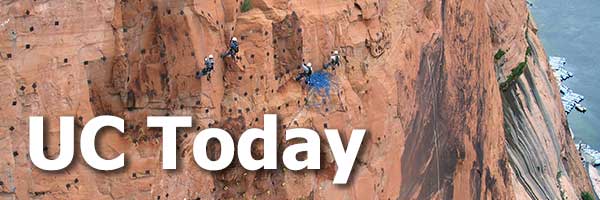 |
|
UC Today is the quarterly newsletter of the Bureau of Reclamation’s Upper Colorado Basin Region covering the states of Colorado, New Mexico, Utah and Wyoming. We look forward to sharing with you some of the projects and activities that we have been working on to manage, develop and protect water and related resources in an environmentally and economically sound manner in the interest of the American public. October 2020 |
|||
| Albuquerque Area Office | Power Office | Provo Area Office Western Colorado Area Office | Four Corners Construction Office |
|||
|
from the |
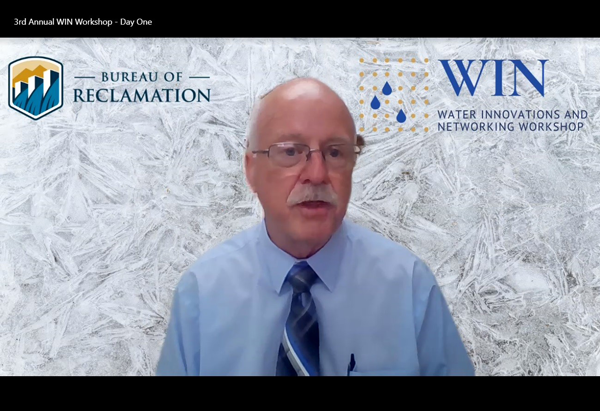 |
| BGNDRF Facility Manager Randy Shaw virtually welcomes workshop attendees. Reclamation photo |
3rd Annual WIN Workshop Finds Success in Virtual CollaborationBy Melissa Romero, Albuquerque Area Office of Public AffairsReclamation's Brackish Groundwater National Desalination Research Facility located in Alamogordo, New Mexico kicked off its two-day 3rd Annual Water Innovation and Networking Workshop on Sept. 23. While navigating a fully remote experience this year, Facility Manager Randy Shaw remained optimistic during the planning phase and coordination of a diverse group of speakers. The goal of the annual workshop is to allow clients of BGNDRF an opportunity to share their work with a broader audience in an environment beneficial for networking with peers, potential customers, investors, and partners. Chief Engineer for Reclamation, Dr. David Raff, PE, D.WRE greeted the online audience with a warm welcome affirming the Agency's open commitment to delivering reliable water supplies. Raff recalled the annual WIN tradition of convening the best minds from across the U.S. and throughout the world while commending BGNDRF's remarkable education outreach efforts to upwards of 2,500 local third graders within the City of Alamogordo's public, private, and home school populations. Yuliana E. Porras-Mendoza, Advanced Water Treatment Research Coordinator at Reclamation's Research and Development Office also presented a detailed overview on seasonal funding opportunity announcements ranging from Desalination and Water Purification Research to Water Reclamation and Reuse Research projects. Reclamation Commissioner Brenda Burman recently highlighted the importance of desalination and recycled water technologies this past summer while announcing selected DWPR projects and awards totaling $5.8 million in federal funding. "Desalination is a tool for communities to find new sources of water to meet their needs today and into the future," said Commissioner Burman. "We are investing in desalination research across the U.S. to make it more affordable and energy efficient, giving communities access to reliable and drought-resistant water supplies." 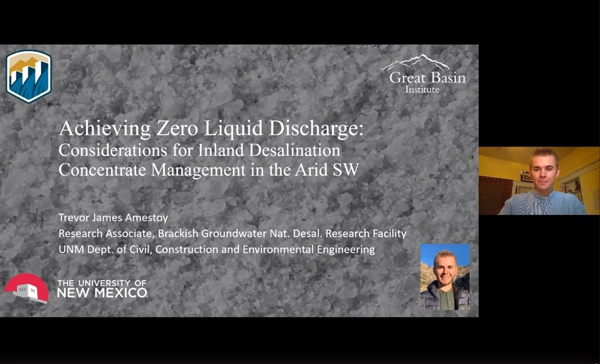 Much of the two-day program included fifteen-minute presentations grouped into leading technology efforts such as desalination with renewable energy, concentrate management, and per- and polyfluoroalkyl substances (PFAS) removal. Recent specialized client projects at the facility include beneficial reuse of concentrate through farming brine shrimp, zero liquid discharge considerations for desalination concentrate management, decarbonized desalination and sustainable agriculture, growing halophytes with reverse osmosis concentrates, and enhanced evaporation of highly saline brine. In addition to Shaw, BGNDRF staff members include the valued team of Dr. Zach Stoll, Physical Scientist, Crystal Bing, Facility Operations Assistant, Dan Lucero, Engineering Technician, and Francisco Nisino, Electronics Technician. While closing out another successful event despite the unprecedented circumstances, Shaw expressed his deep gratitude to all present for rising to the occasion in support of this noteworthy annual opportunity. |
|
from the |
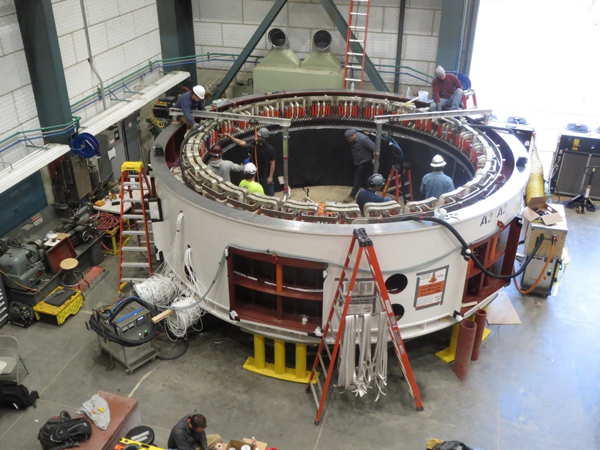 |
| Blue Mesa Stator being assembled on-site. Reclamation photo |
Major Equipment Upgrades in CurecantiBy Larry Lingerfelt, Curecanti Field Division Manager and Eric Langley, Blue Mesa Powerplant Supervisor IIThe Curecanti Field Division is nearing the end of a multi-year, multi-million-dollar contract to upgrade and modernize its powerplants. In 2016 Toshiba America Energy Systems was awarded a contract to install new excitation systems at Crystal, Morrow Point, and Blue Mesa and a complete rehab of both generators at Blue Mesa. Toshiba started with exciter replacement at Crystal in early 2017. The exciter creates the electromagnetic field in the rotor of a generator; without the electromagnetic field the generator would not produce any electricity. After completion of Crystal, Toshiba moved on to Morrow Point and completed exciter replacement in April 2018. After completion of Morrow Point, Toshiba started building the first new stator for Blue Mesa. 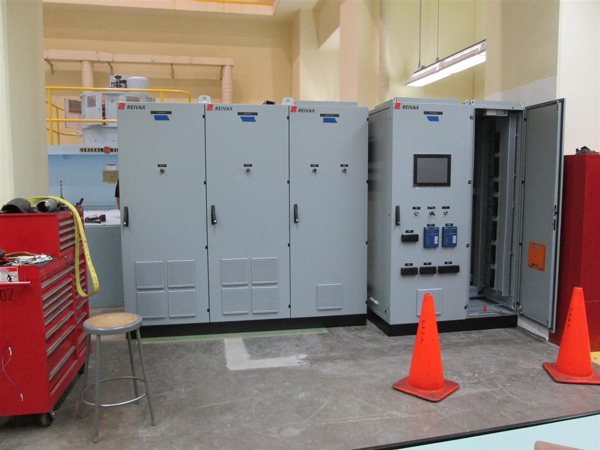 Starting in July 2019, Blue Mesa Unit 1 generator was taken off-line for a major rehabilitation. The rehabilitation required the generator to be completely disassembled; to include removal of rotor, removal and replacement of stator, and various ancillary equipment, a tremendous amount of work. As is common with most contracts of this scope, unforeseen things come up that delay work, this contract was not an exception, but due to the diligence of an excellent team comprised of Curecanti personnel, the Upper Colorado Region Power Office and the outstanding support from Lisa Hilton and her Acquisitions Team working with the contractor the delays were minimized as much as possible. Even with an excellent team, as we've all experienced in 2020, we could not avoid the impact of COVID-19. Blue Mesa Unit 1 was within a few weeks of completion when the pandemic struck requiring us to stop all contractor work and enter "Protect the Pilot" mode of operations. After a four-month delay, while we worked out how to adjust to a "new normal", Toshiba was finally allowed to return to work on August 5. Toshiba picked up where they left off in March and completed the work and commissioning of Blue Mesa Unit 1 on September 25, 2020. On October 19, 2020 Toshiba will start work on the second and final generator at Blue Mesa with a projected completion date of April 2021. Upon completion Blue Mesa, Morrow Point, and Crystal powerplants will be positioned to provide reliable service for the next 15-25 years. Blue Mesa, Morrow Point and Crystal power plant and dams are part of Reclamation's Wayne N. Aspinall Unit of the Colorado River Storage Project, which retains the waters of the Colorado River and its tributaries for agricultural and municipal use. The project furnishes the long-term regulatory storage needed to permit States in the upper basin to develop their share of Colorado River water and still meet their flow obligation at Lees Ferry, Arizona, as defined in the Colorado River Compact. |
|
from the |
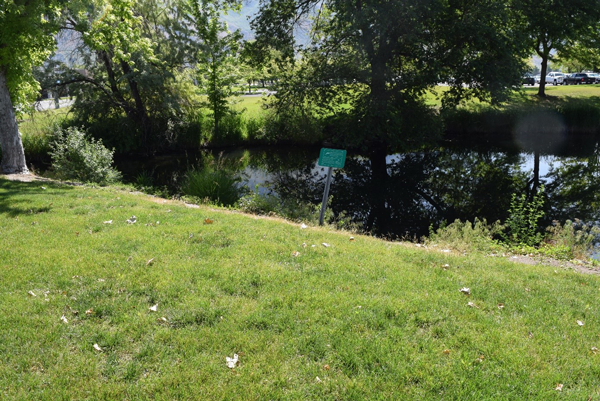 |
| June 11, 2019: East View of East Bay Retention Pond (Day Use Accessible to Public). Reclamation photo |
East Bay Retention Pond Parking Rehabilitation ProjectBy Deborah Hilton, Administrative OfficerIn August 2020 construction began on the East Bay Retention Pond Parking Rehabilitation Project. The front parking area was partially funded through a Department of Transportation grant for improvements to lands accessed by the public. The public uses this parking area to access the East Bay Retention Pond for day use activities such as fishing, observing waterfowl, picnicking, and other day-use recreation activities as well as to access the new Lakeview Parkway Trail. 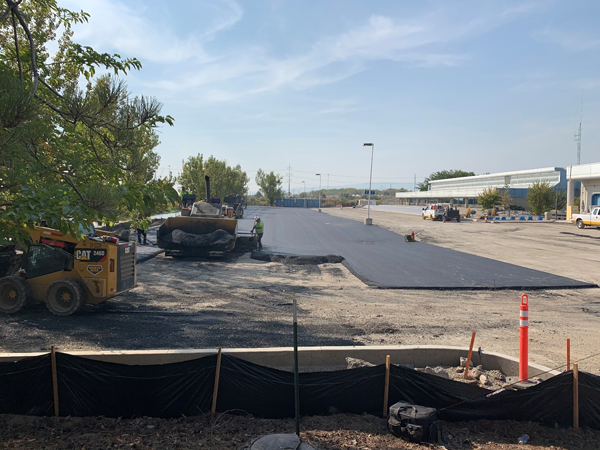 The Provo Area Office building and parking area were constructed on reclaimed land over a former city landfill which added unique challenges. Since construction of the building and parking area in the 80s, the subbase has shifted, causing the surface of the asphalt cement concrete to sink in places. This created low and high spots in the parking area surface resulting in ponding as the water was unable to drain to the catch basins. Because of improper storm water drainage, water from melting snow and ice was trapped and froze in the low areas creating dangerous conditions for pedestrians and vehicles. This project was needed to create safe conditions for recreators, employees, and visitors. The contractor has completed the major components of the back-parking area and is currently working on the front-parking area and pavilion. Estimated date of completion (substantially complete) December 2020. |
|
from the |
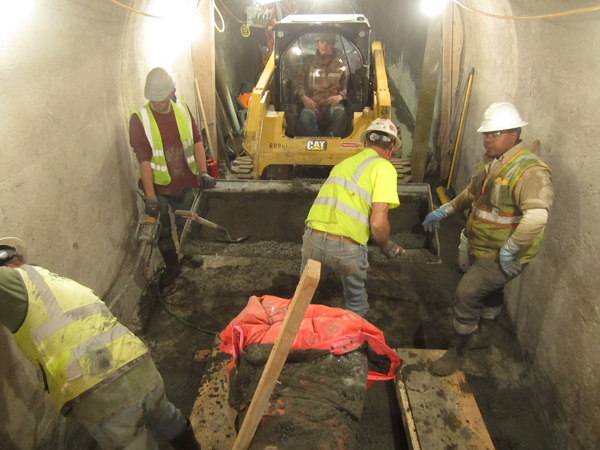 |
| Skid steer delivering concrete for the repair of the tunnel invert. Reclamation photo by Matt Bryner |
Western Colorado Area Office roundupBy Matt Byner, Civil Engineer and Justyn Liff, Western Colorado Area Public AffairsPaonia Dam ModificationsThe second phase of the Paonia Dam Outlet Works Modification Project is about to begin. Work to be accomplished this year will begin with the placement of a bulkhead over the intake. The diving barge had to be placed in July before reservoir levels dropped to the point the boat ramp could no longer be used. A dive team is scheduled to arrive at the end of September and will be working from the diving barge placing the bulkhead in October. 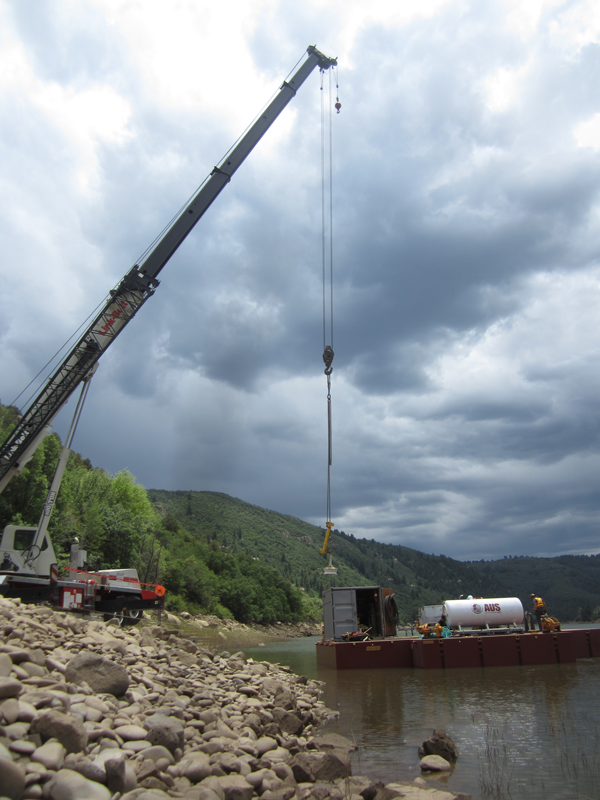 Once the bulkhead is placed there is no outlet for the reservoir water until the water level reaches the emergency spillway. The water level will continue to slowly rise throughout the winter months. During this time the contractor, Gracon LLC, will be racing against the rising water to complete emergency and regulating gate rehabilitation and install a new air relief system in the inlet tunnel. This work must be accomplished before water begins to flow down the emergency spillway as the only access large enough to move the new components into the dam gate chamber is through the outlet tunnel at the bottom of the emergency spillway. Historically the reservoir level will reach the emergency spillway somewhere between March and May. Gracon's construction schedule shows outlet tunnel access work to be finished by March. Work completed last winter – Phase 1 – included removal of the outlet tunnel cover, removal and replacement the concrete invert immediately in front of the outlet gates in the outlet tunnel and disassembly and survey of the emergency and regulating gates that will be updated in Phase 2. The outlet tunnel cover had to be replaced and access scaffolding removed prior to water flowing down the emergency spillway. Volunteers Build Bird Boxes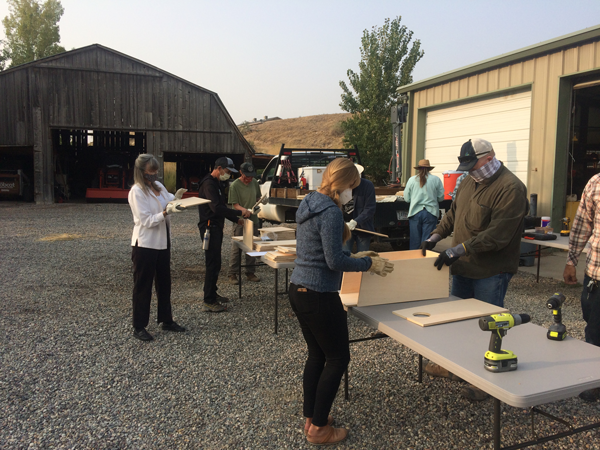 The Western Colorado Area Office was thrilled to be approached by RiversEdge West and Xcel Energy to be part of "Xcel Energy's Day of Service". Sept. 17, about 12 volunteers from Xcel and employees from RiversEdge West and the Western Colorado Area Office met at the Grand Junction Wildlife Area located in Grand Junction, Colorado to build wood duck and owl nesting boxes. The boxes will provide a safe place for the birds to build their nests that is protected from the elements and predators. 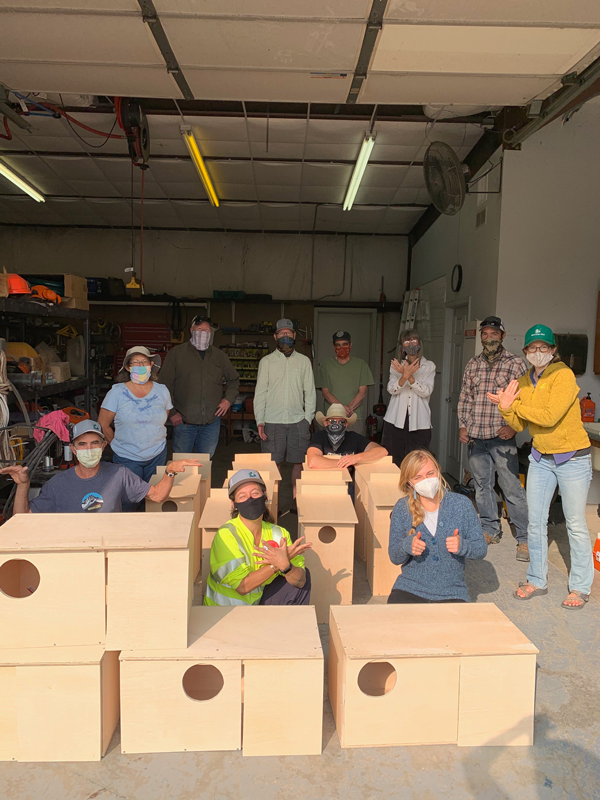 The Western Colorado Area Office provided the materials, and employees Cory Lidberg and Kyle Alstatt prepared for the event by cutting out all the needed pieces, organizing tools and personal protective equipment, setting up the site and demonstrating box construction. Participants social distanced outside and wore face masks when near each other. A total of 14 new wood duck and owl nesting boxes were completed. RiversEdge West is a non-profit organization that works to restore rivers and improve riparian habitat across the Southwest. More information can be found at riversedgewest.org. "Xcel Energy's Day of Service" began in Colorado in 2010 to honor the anniversary of Sept 11. It is the company's way of thanking individuals and organizations serving our communities and country. |
|
from the |
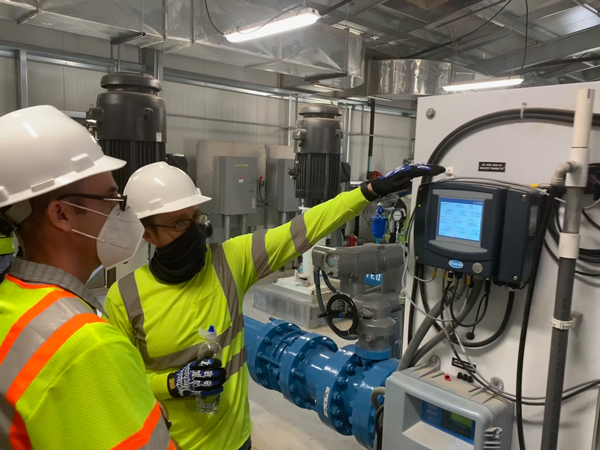 |
| Reclamation staff inspect the effluent water quality readout during Monitored Testing 2 of the Cutter Lateral Water Treatment Plant. Reclamation photo |
Cutter Lateral Being Prepared for Water DeliveryBy David Stoliker, P.E., Design Group ChiefConstruction of the Cutter Lateral Water Treatment Plant is nearing completion and testing of the plant and entire Cutter Lateral system has begun. A team of professionals from the Navajo Tribal Utility Authority, Navajo Nation Department of Water Resources, New Mexico Environment Department, Navajo Nation Environmental Protection Agency, Navajo Engineering and Construction Authority, private consultants (Jacobs, Woods and Souder Miller & Associates), and the Bureau of Reclamation are holding daily meetings to coordinate every detail needed to ensure that all systems are ready to start producing and delivering good, clean drinking water. Some actions being discussed include:
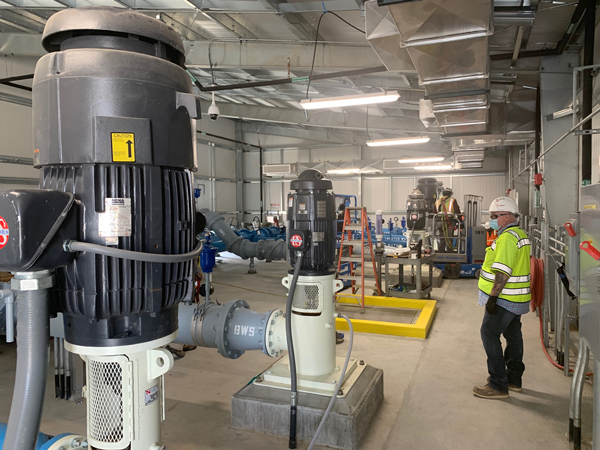 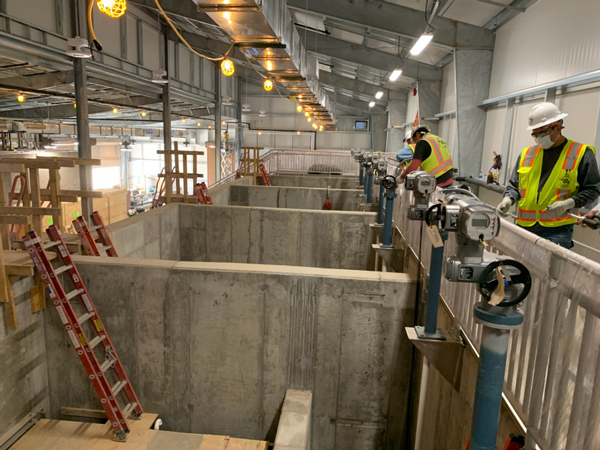 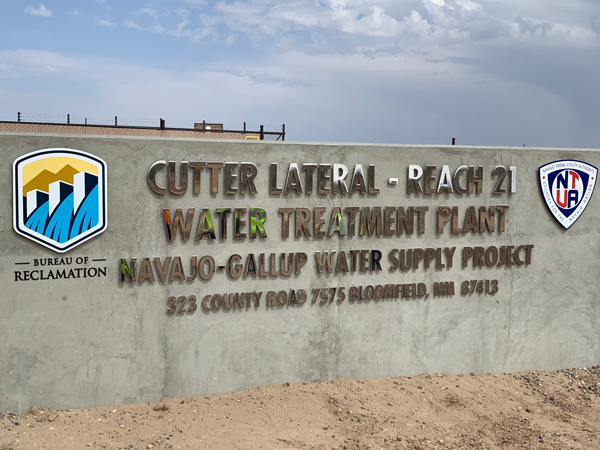 |
Commissioner Burman's Message on New LogoThe Bureau of Reclamation is modernizing our visual identity, including the logo, as part of a proactive effort to better articulate the important work we do. The new visual identity and logo improves accessibility, is more suitable for digital communications, and can be more uniquely and directly associated with Reclamation. |
Interior Region 7 • Upper Colorado Basin 125 South State Street, Room 8100 Salt Lake City, Utah 84138-1147 If you would like to subscribe or unsubscribe to this newsletter, please send an email with your first and last name to ucbpao@usbr.gov. |